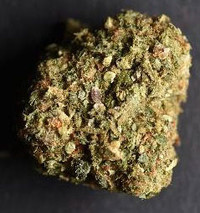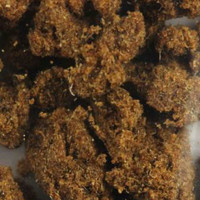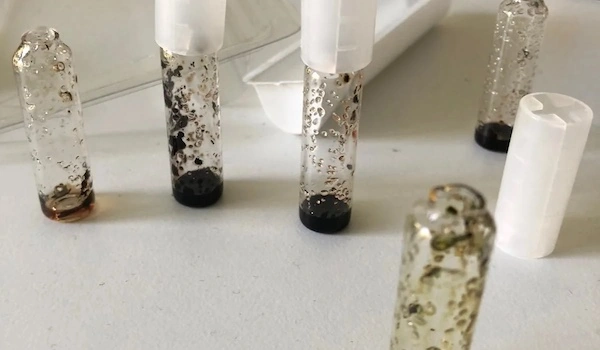How to detect synthethic cannabinoids
Synthetic cannabinoids such as MDMB-4en-PINACA are compounds designed to mimic the effects of THC, the main psychoactive ingredient of cannabis. They are very cheap to manufacture, therefore often sprayed on various plants, even hemp and missold as cannabis for profit. One of the main characteristics of synthetic cannabinoids is that unlike THC or CBD they are often full agonists of the CB1 receptor (mostly responsible for the typical cannabis experience). This means that unlike THC or CBD the synthetics can cause a serious injury, both physical (kidneys, heart) and mental (paranoia, psychosis), even a fatal overdose.
Although first synthetic cannabinoids were initially developed starting in the 1960s, following the isolation of THC, it was only around 2005 when they begun to be widely sold worldwide as a legal marijuana alternative. Since the original release due to consecutive international bans every next generation was designed to circumvennt the law – the quality of effects deterriorated, while potency and risks have increased.
A subjective user experience report (Reddit, 2021):
This is a big problem in Europe and nobody is aware of the problem. Here in Germany at least 50% of the weed is laced with synthetic cannabinoids. The older synthetic cannabinoids that are not that strong are not that easy to differ from normal weed but in my experience the high was way more energetic and stimulant like( depends on noid). What I also felt was a strong punctual sting in my brain during the high which came like every 5 min. Even after I left the black market and got homegrown stuff like one year ago the stings keep coming back no matter if I’m sober or high. I have some friends that have the same problem. The newer synthetic cannabinoids are crazy! I once got weed laced with a potent cannabinoid like MDMB-4EN-PINACA. After smoking one joint (0,3g) with four friends I found myself in a full-blown trip that was even stronger than my LSD( medium dose) and Mushrooms ( medium to strong dose) experiences. I was so glad that they just last like 30 min because this is fucking terrifying if you expect a weed high. The only thing I found out for myself to detect the laced weed (doesn’t look and smell different) is that it didn’t dry. Normally weed would be touch dry if you leave it on the heater for one or two days but that shit doesn’t dry. ( Just my experience) Anyways you should get a test kit or if you have the ability send it to a lab that analyzes it for you.
Laced weed even in a coffeeshop
Due to the rise of supply of legal low-THC cannabis products in Europe researchers have begun to record rise in such products adulterated with synthetic cannabinoids (full text). “Fake weed” was detected in 2021 in Germany, Switzerland, United Kingdom, France, Austria, Luxemburg, Italy and even in a coffeeshop in the Netherlands. Adulterated cannabis flowers and extracts can not be reliably distinguished simply by smell or looks, as demonstrated below on samples from saferparty.ch:
How to test cannabis
Not all reagents are made equal. Prior to 2020 the approach to testing cannabis was to try to positively identify the adulterants. This proved futile due to the amount of possible synthetic cannabinoids, as well as notorious false positives with any plant matter:
Fortunately there are other reagents for testing cannabis, most notably the Cannabis reagent (4-AP) and the Beam reagent (Zimmermann). These take an indirect approach, much like using Ehrlich reagent for testing LSD. Instead of checking directly for an adulterant the reagents determine if a sample has high CBD/THC content, low or none. If there is no THC although sample is expected to be highly psychoactive then the product is either bunk or adulterated.
Technically false positives are still possible, especially with samples containing 1:1 THC:CBD ratio, but such products are rare and valuable, therefore do not make sense financially to adulterate. Lab analysis services have not detected any false positives as of yet (Swiss report). The Cannabis reagent (4-AP) is widely used by Swiss police forensics as well as the DEA and has proven extremely reliable so far.
How to test cannabis using reagents:
- Examine if sample resembles a cannabis flower (orange/white pistills “hairs” and tiny trichome glands)
- Use Cannabis reagent (4-AP) to determine if a sample is THC dominant
- Use Beam (Zimmermann) reagent to estimate CBD level
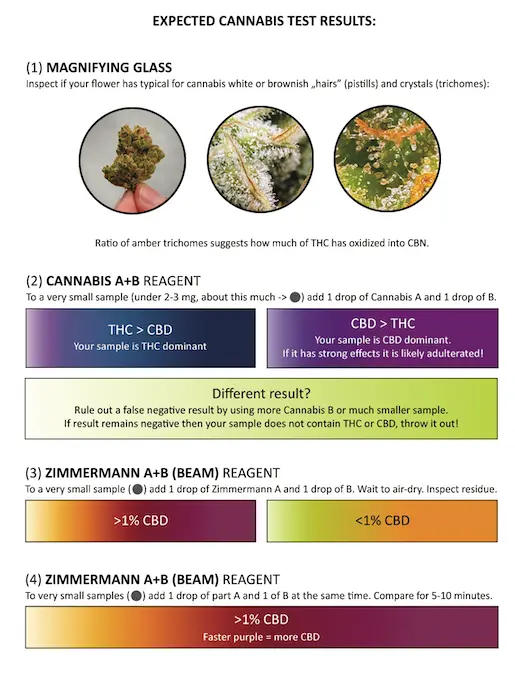
Cannabis reagent testing results:
| TEST | CBD > THC | THC > CBD | Synthetic cannabinoids |
| CANNABIS (4-AP) | purple | blue | no reaction (greenish) |
| ZIMMERMANN (BEAM) | purple | no reaction (greenish) | no reaction (greenish) |
The THC:CBD ratio has to be at least 3:1 (or 1:3) for easiest to interpret results.
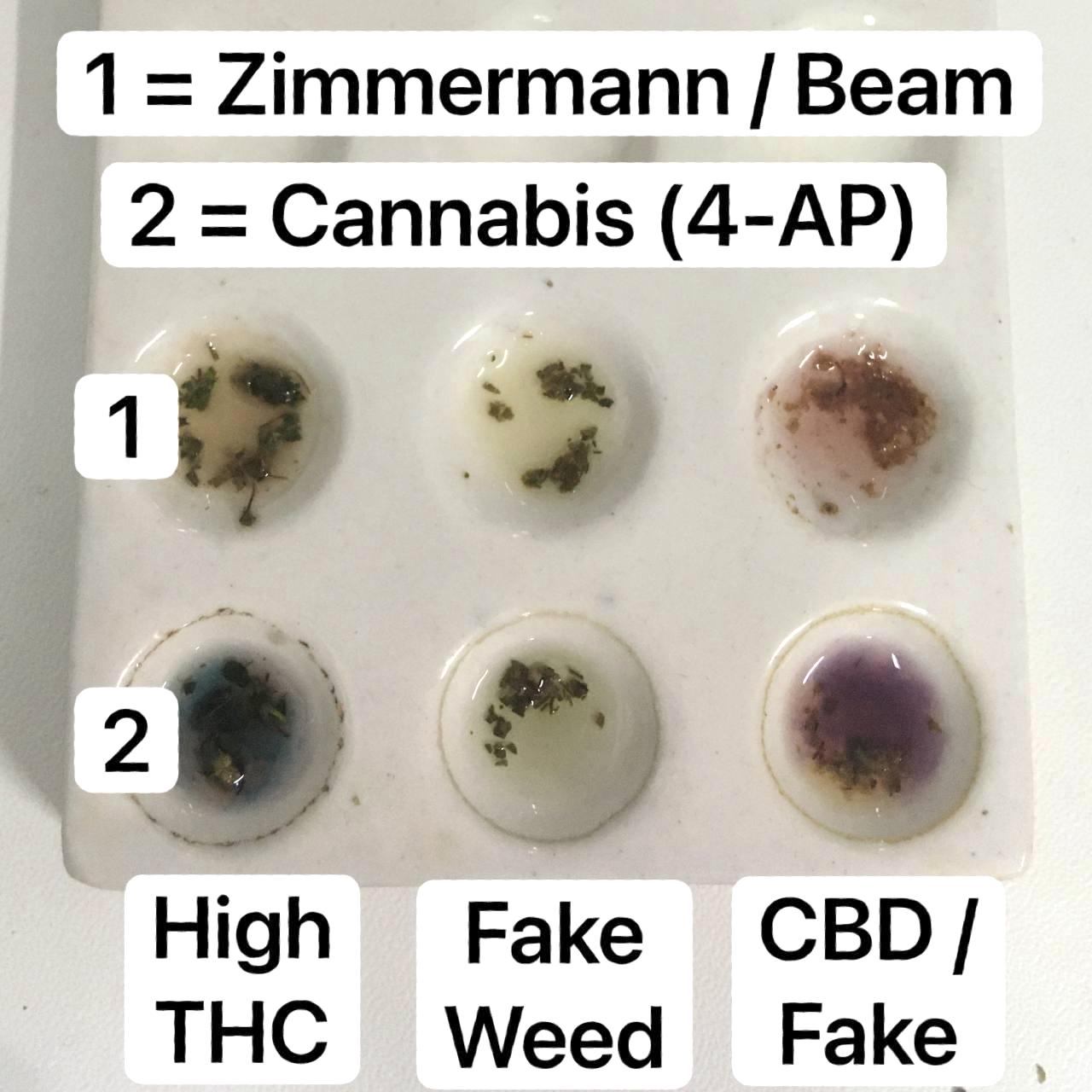
Start reducing harm now and order your cannabis test kit today!
Reagents presumptively indicate PRESENCE, but not QUANTITY. To detect all ingredients and estimate potency it’s required to use an additional purity test kit. A positive or negative test result does not indicate if the substance is safe. No substance is 100% safe.
